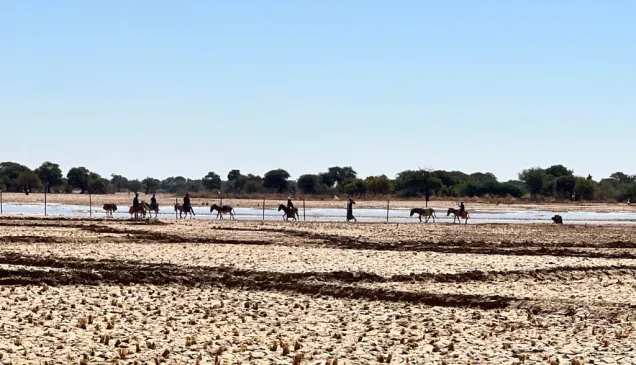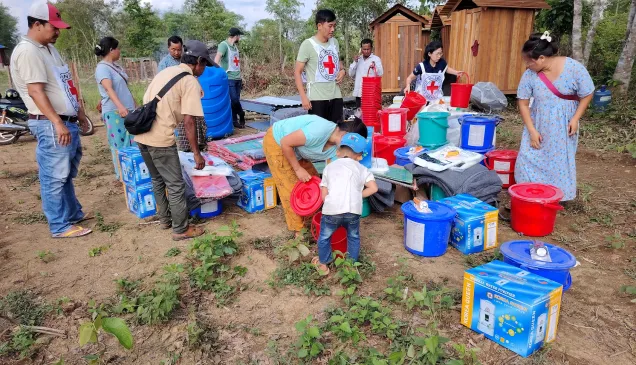Sustaining resilient humanitarian action in the Middle East
Presentation to the 15th edition of DIHAD
Dr Hugo Slim - head of policy and humanitarian diplomacy - ICRC
Presentation to the 15th edition of Dubai International Humanitarian Aid and Development (DIHAD)
DIHAD conference and exhibition on the sustainability of emergency aid
Thank you for inviting the ICRC to address this 15th DIHAD. It is a pleasure to be here and I would like to add the ICRC’s thanks to the United Arab Emirates for their significant financial, diplomatic and policy support to global humanitarian action.
A couple of years ago, we at ICRC made some calculations about the longevity of our operations. We realized that we had been present in our top ten operations for an average of 36 years. In places like Afghanistan, DRC, South Sudan, Iraq, West Bank and Gaza, we have had to sustain humanitarian operations for decades. This figure of 36 years finally puts an end to the old myth that humanitarian action is some sort of short, quick-in and quick-out business of urgent and immediate aid.
The real challenge for humanitarian action in protracted conflicts is to offer some form of enabling humanitarian accompaniment over the long-term to people whose lived experience of conflict lasts for decades and generations. Their lived experience is of destruction, loss of home and livelihoods, repeated displacement, family separation, a crisis in basic services and entrenching impoverishment.
A Combined Approach
To accompany people over time, the ICRC works with people in a “combined approach” that works both short and long on the problems people face. In protracted and volatile situations, we operate simultaneously with two time horizons: this week, and 3-5 years time. We are continuously working on people’s survival needs today and tomorrow – for food, water and medicines - but we are also constantly working on their deeper means of survival - water and electricity systems, local economy and basic services the will rely on to survive as conflict continues.
This means the ICRC’s humanitarian action is always focused on two priorities at the same time: individual needs and system needs. This approach compares to the humanitarian-development nexus that others have spoken of today. But international humanitarian law (IHL) is not concerned with bureaucratic distinctions between relief and development. IHL cares about people’s protection and survival, the sustainability of their means of survival, their ability to continue in a life with dignity, and the conduct of hostilities around them.
So, I will focus on three key challenges today that affect the sustainability of humanitarian action in protracted conflict: sustaining respect for IHL in today’s protection challenge; sustaining basic services in today’s urban revolution in humanitarian action, and sustaining self esteem in people’s struggle for resilience.
Sustaining respect for IHL
Sustaining people’s protection over time is a challenge of sustaining respect for IHL. This is the first and biggest humanitarian challenge in long and volatile wars.
Sustained respect for IHL in the conduct of hostilities and the continuing obligation to ensure the provision of relief to the affected population are requirements of IHL. The duration of the conflict does not affect these obligations. IHL applies throughout an armed conflict and standards must not drop over time.
Our evidence suggests that in most protracted conflicts people’s conditions deteriorate because the same violations of IHL are repeated over time.
Certain patterns of violence develop early as signature violations of a conflict and are then repeated throughout the conflict unless they can be stopped by determined protection work and a change in incentives for the parties to conflict. This suggests that the repetition of violations rather than a gradual deterioration into violations is the main challenge in protracted conflicts.
It is this repetition that creates the deep cumulative impact of violence and violations on the civilian population, and causes an entrenching deterioration in people’s conditions from displacement, destitution, the degradation of basic services, economic destruction, ill health and the impoverishment of war.
It is essential to maintain protection momentum in these long-term contexts of repeated patterns of violence, violations and cumulative impact, and to argue with determination for respect of IHL. Sustained protection work needs to reduce repetition by preventing and mitigating patterns of forced displacement, sexual violence, attacks on health facilities, inhumane detention practices and the obstruction of relief.
Here the role of military coalitions is key. Many of today’s armed conflicts are fought between coalitions made up of several States and armed groups. These partnered operations involve large numbers of parties to conflicts across the Middle East with different members of each coalition playing various roles as suppliers, trainers, advisors and frontline fighters.
Every member of such coalitions has an obligation to respect IHL and should also work at all times to the maximum extent possible to ensure that their partners also respect IHL. Operating on a principle of deferred responsibility risks a weakening of respect for humanitarian law, which may have serious consequences for people’s protection.
The ICRC calls on all parties involved in such partnered operations to respect IHL, and we stand ready to advise them on practical solutions to coalition problems around training, devolved responsibility, detention and other operational challenges.
Here is the first major challenge of protection in protracted conflict: the long-term resilience of humanitarian norms across a conflicted society and the sustained respect for IHL. It must remain a priority for parties to conflict at all times, whether fighting alone or in a coalition.
Sustaining urban services
The second challenge is urban resilience. The recent conflicts in the Middle East have forced an urban revolution on the practice of humanitarian action. The ICRC is working hard to rise to this challenge and develop effective forms of urban humanitarian action.
The big challenge of humanitarian action in towns and cities is its scale and density of population, infrastructure and human networks. Urban space is crowded and reliant on sophisticated and interconnected social and economic infrastructure.
This has required a technical revolution in the way we work. For example, our water and electricity work has dramatically changed from boreholes and small generators to huge power plants, water treatment centres and distribution systems for millions of people in Iraq, Syria, Gaza and Yemen. In Bangui, in Central African Republic, we found it essential to take over a major city-wide water piping and treatment project suspended by the World Bank. They shared the design plans for a project designed as “development” infrastructure and we completed it urgently as a vital humanitarian service to prevent a public health crisis in areas affected by violence and rising numbers of IDPs.
The sustainability of urban services is essential as people’s means of survival and involves technical capacity of unprecedented sophistication for the ICRC. System continuity involves maintaining supplies, staffing and repairs over years. The widespread use of explosive weapons in urban environments leads to repeated damage and disruption.
Our work in urban health faces new challenges of non-communicable diseases in previously Middle Income Countries, and our economic security work will increasingly need to step up from micro-enterprise work with individuals to support meso financing to ensure the business continuity of small and medium enterprises (SMEs) like bakeries, supermarkets and manufacturers that provide essential supplies to civilian populations in towns and cities.
The resilience of urban systems is, therefore, one of our biggest concerns in today’s armed conflicts. Interestingly, this is one of many areas of humanitarian action that finds common ground with the SDGs of Agenda 2030.
Sustaining self esteem
Finally, the ICRC would like to pay tribute to the personal resilience of the people of the Middle East.
I have spoken of urban resilience and the resilience of humanitarian norms but it is the personal resilience of so many millions of people affected by conflict in the Middle East that makes their survival possible.
Personal resilience comes from within – our emotional and psychological infrastructure and the sustenance of family and wider social networks. Personal resilience is made from courage, adaptability and hope.
It was a woman, Princess Haya, who launched our conference today, and it is also International Women’s Day on Thursday. So, the ICRC would like to pay particular respect to the power and strength of the millions of women on the frontlines of conflict across the Middle East. Their personal resilience – tested by terrible personal suffering and loss – is often deeply admirable. Women are a vital source of strength and support to all of those around them as mothers, wives, sisters and daughters, and as earners for their families, and the organizers of many wider public goods in schools, health facilities and voluntary initiatives of all kinds across the Arab world.
Humanitarian action can accompany and support such personal resilience but it cannot create it. This power comes from women themselves.



